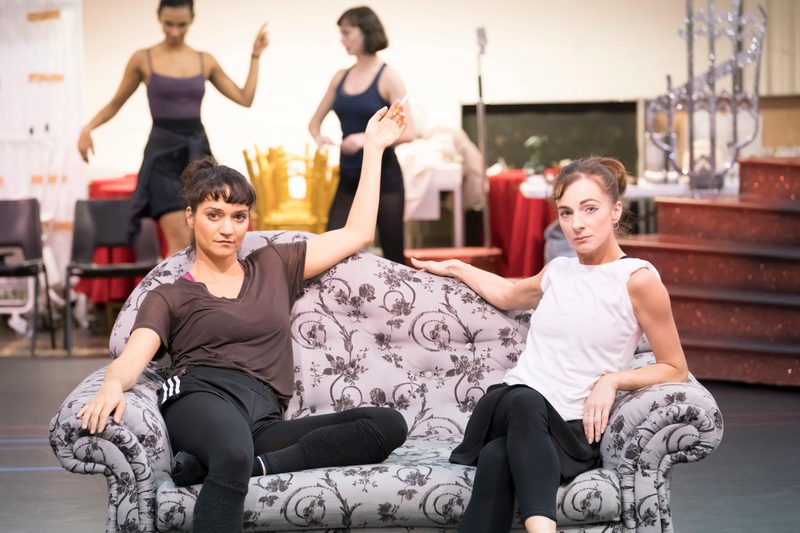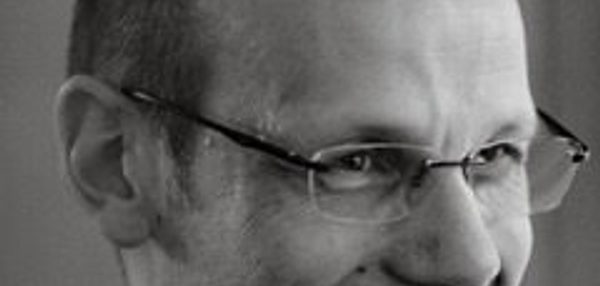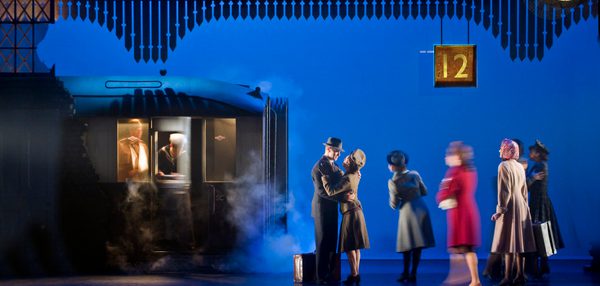Music & Sound
Delve into the music and sounds of Matthew Bourne's Cinderella with Paul Groothuis, Sound Designer for the production. Then find out more about the composer of the show, Sergei Prokofiev, with Brett Morris (a New Adventures Associate Artist).
Paul Groothuis discusses what it's like to work with New Adventures and designing the soundscape for Matthew Bourne's Cinderella, which on top of the infamous Prokofiev score features sound effects that transports you back to 1940s London during World War II.
Interview with Brett Morris
Prokofiev wrote many ballet scores. Can you tell us something of how this one came about?
This was the sixth ballet score that Prokofiev composed, written for the ballerina Galina Ulanova. Having begun the composition in 1941, Prokofiev broke off working on the score following the German invasion of Russia, concentrating his efforts on his new opera War and Peace, something he felt more fitting given the circumstances. He completed the score of Cinderella in 1944, and it was premiered by the Kirov ballet in 1945.
Interestingly, the Russian authorities relaxed their previous artistic restrictions somewhat during the war years, freeing up Prokofiev to write in a more personal and complex style, and these years marked a tremendous creative period in his artistic life. Significant pieces such as the monumental Fifth Symphony, the film score Ivan the Terrible, and some of his finest piano and chamber music, emerged from this period, alongside the superb score for Cinderella. As failing health and political hostility increasingly took its toll on Prokofiev's creative life, Cinderella was to become his last great work for the theatre.
Could you tell us something about the musical qualities and characteristics of the score for Cinderella?
Perhaps the first thing that strikes the listener is how evocative and expressive the music of Cinderella is. For example, the very first bars we hear transport us to the bleak and unhappy situation Cinderella finds herself in (this is the music which accompanies the Pathe film images in Matt’s production). This initial bleak theme is then followed by what we might call a “yearning” theme in the major key, which conveys the character’s wish for a different life. We then return to the seeming emptiness of that hope for Cinderella as the music changes back to the opening bleakness, before the music fades away and the scene with the ugly sisters begins. So within a couple of minutes we are musically transported to the emotional heart of Cinderella’s journey through the ballet.
Prokofiev uses these themes, and many others which are associated with different characters (such as the ugly sisters, fairy godmother/Angel, Cinderella’s father, the Prince, and so on) in various guises throughout the ballet. This not only gives a sense of coherence to the overall structure of the piece, but also allows Prokofiev to show the different emotional states the characters are in as the piece progresses. So whilst the setting of the story is in the realms of a “fairytale”, actually the character of the music is extremely human and deep.
Next, the listener is struck by the dazzling orchestration of the score, that is, how the composer uses the orchestral forces at his command to maximum and brilliant effect. Through this use of orchestration Prokofiev is able to convey the character of a scene, or of a particular character in the ballet.
For example, the ugly sisters’ music is grotesque, not just in terms of the angular melodic lines and scrunchy and dissonant harmonies which accompany them, but also in terms of the orchestral colour employed. Having the strings play sul ponticello (a scratchy and thin sound caused by using the bow near the bridge of the instrument), or the biting muted brass chords and shrill woodwind writing evoke a cold, harsh, and brittle quality, which typifies the character of the ugly sisters themselves.
By contrast, Cinderella’s purity and simple goodness is often reflected in the more straightforward and lyrical nature of her music. Her character is also conveyed in the natural and warm sounds of the scoring, such as the delicate writing for the flute and other solo instruments Prokofiev employs. The fairy godmother/angel music has a magical suspended quality, carefully evoked by the composer’s use of harp, percussion, piccolo and celeste.

How might the score of Cinderella differ from his other famous ballet score, Romeo and Juliet?
Although it’s hard to believe now, when Romeo and Juliet was initially premiered in 1935, the score was regarded by some as problematic. It was even proclaimed to be “un-danceable”! This was, in part due to Prokofiev’s use of large spans of music throughout each act, making the score feel more “symphonic” than would usually be the case with music for a classical ballet. So when it came to writing Cinderella, Prokofiev decided to adopt a different approach, and in fact he dedicated the score of Cinderella to Tchaikovsky.
In contrast to Prokofiev’s writing in Romeo and Juliet, in Cinderella we find many short pieces in traditional dance forms, such as the waltz, gallop, bouree, gavotte, mazurka, grand adage, and the passepied. There is constant contrast and change as we progress from number to number, for example in the ball scene, and in the Prince’s search for Cinderella in act three. This constant change propels the action forward and ensures that the momentum is sustained throughout the ballet. The succession of musical numbers also seems to create an undercurrent of tension and edge throughout the entire score, until we arrive at the final scene with the lyrical ¾ Amoroso and pas de deux. It is only at this point, that the music seems to have reached its destiny, as the characters have reached their own. There is a resolution in the simple key of C major, with the final upward scales on the celeste bringing the piece to a close.
Can you say something about the process of recording the score for this production of Cinderella?
The process of the recording the score for performance is a complex one, and one which involves much preparation for the conductor. With Cinderella the recording had to be made ahead of the studio rehearsals with the dancers, so Matt and I had many conversations about his scenario for the ballet, what he was wanting to achieve at each moment in the score, and what might be suitable speeds, or “tempi”, for the dancers. This enabled me to know exactly what I was aiming to achieve with the music at any given point in the ballet by the time we went into the studio with the musicians to record the score.
The score is written for a large orchestra and it took us four full days to record it in its entirety. The musicians arrive in the recording studio not having seen their parts beforehand, and so we would rehearse a section and then record it. The score is virtuosic in the demands it makes on the players, so even though four days might seem like quite a long time to record less than two hours’ music, we actually used all that time.
In order to be efficient about the use of the large orchestral forces, the piece was not recorded in the order in which it appears in the ballet. We grouped together pieces with similar orchestration and recorded these at the same time. This is why the advance preparation for the conductor was so essential, in order that I could achieve the correct “tempo” (or speed) and emotional feel for each number in the score, as we recorded them, out of performance sequence.
Go Back


